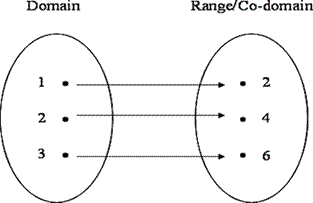
Function → View it...
In the expression y = f (x) (which is read as: y equals f of x or y is a function f of x), f is the rule which assigns to every x in the domain of f a unique value y in the co-domain (range) of f.
Convention: The term function is often used loosely and this is the habit that has also been adopted in this book. However, students answering questions about functions must adhere to the definition above.
Example: An example of a function is y = 2x. This equation may be written in the form below, which clearly shows the terms used in definition above:
f : x → 2x
The above is read as: f is the rule that maps x into 2x. This is called a mapping and it may be represented diagrammatically as shown in the figure below. Notice that only a few illustrative values have been included.

A mapping diagram
Note:
If the y value is not unique, then it is not a function. For instance, consider the expression x = y2. Since x = 2 and x = -2 both give y = 4, then this is not a function by the definition mentioned above.
Generally speaking, if
we have the mapping f : A
→ B, where A is the domain and B is the co-domain
(range), then f is a function if for each a
![]() A
A
![]() a unique b
a unique b
![]() B, where b = f (a). Leading
on from this, we may define the image set of f as Im f = {b
B, where b = f (a). Leading
on from this, we may define the image set of f as Im f = {b
![]() B s.t.
B s.t.
![]() a
a
![]() A s.t. f (a) = b}. Furthermore, the inverse mapping of f is
f-1 : B → A.
A s.t. f (a) = b}. Furthermore, the inverse mapping of f is
f-1 : B → A.
Example: Let A = {a,b,c,d} and B = {v,w,x,y,z}, where f : A → B according to the mapping diagram shown below.
